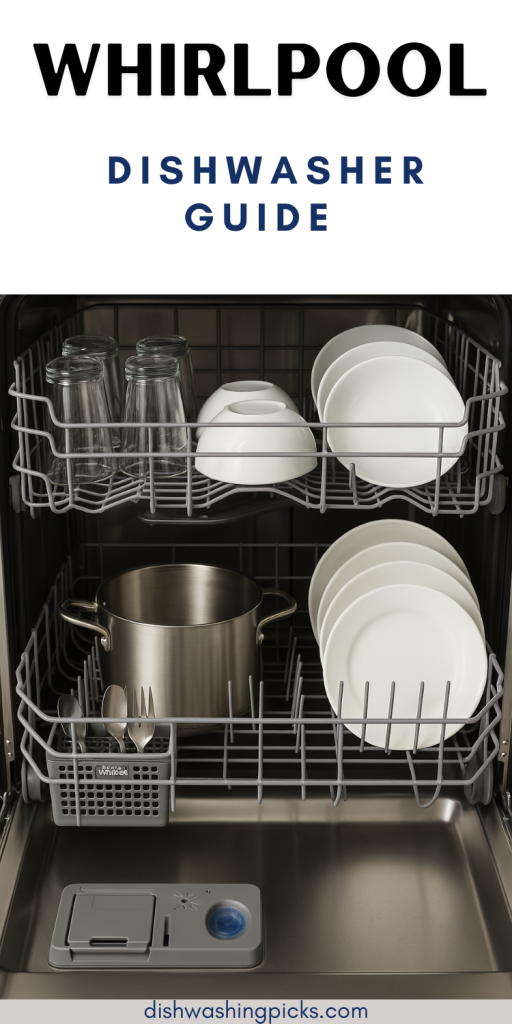So, you’ve got yourself a Whirlpool dishwasher—or maybe you’re eyeing one in the store—and you’re wondering, “Okay… how do I actually use this thing without messing it up?”
Totally fair question. These machines are designed to make your life easier, not stress you out. But with all the buttons, settings, racks, and fancy detergent talk, it can feel like your dishwasher’s got a mind of its own.
No worries. This guide’s here to break it all down. Easy-peasy.
Step 1: Meet Your Dishwasher (Like, Actually Look at It)
Before you go pressing buttons like it’s a game show buzzer, take a minute to check out the layout. Almost every Whirlpool dishwasher (old or new) has the same main parts:
- Top rack → Think mugs, glasses, smaller bowls, and plastic containers.
- Bottom rack → This is your heavy-duty zone. Plates, big bowls, pots, pans—go wild.
- Silverware basket → Knives down, folks. Safety first.
- Detergent dispenser → Usually on the inside of the door.
- Rinse aid compartment → Right next to the detergent one.
- Control panel → Where the magic happens (or the confusion starts, if you don’t know what to push).
Got it? Cool. Let’s talk loading, ‘cause believe it or not, there’s a method to the madness.
Step 2: How to Load It (Without Starting a Household Argument)
You’ve probably heard this debate: “No, the forks go in handle-up!” or “You can’t just throw a pot in sideways!”
Well, here’s the deal:
Yes, there is a right-ish way to load a Whirlpool dishwasher. And no, it’s not rocket science.
Top Rack:
- Put glasses between the tines, not over them (less risk of breakage).
- Lay plastic containers on an angle so they don’t pool water.
- Bowls? Face down or sideways to catch the spray.
Bottom Rack:
- Load plates facing the center.
- Keep space between items so water can get through.
- Pots and pans? Angle them downward to let water flow out.
Silverware Basket:
- Mix it up: some handle-up, some handle-down.
- Knives? Always pointy side down.
- Don’t nest spoons together—they like to spoon each other and block water flow.
Alright, your dishwasher’s loaded like a pro. Let’s hit those mysterious buttons next.
Step 3: Choosing the Right Cycle (Aka Which Button Actually Matters?)
Okay, this is where people tend to overthink. Whirlpool gives you options, sure, but most of the time you’re using like… three of them max.
Here’s a quick cheat sheet:
- Normal Cycle: Your go-to for everyday dishes.
- Heavy Duty or Pots & Pans: Caked-on spaghetti? This setting’s your bestie.
- Quick Wash: In a rush? This works if your dishes aren’t too grimy.
- Sensor or Auto: The dishwasher decides for you. Yes, it’s that smart.
- Rinse Only: For when you’re not ready to run a full load but don’t want things smelling funky.
And hey, you can’t really mess this part up. Worst case? Your dishes just don’t come out perfect—but now you know what to tweak next time.
Step 4: Rinse Aid—Yes, You Should Use It
Wait, what the heck is rinse aid? Do I need it?
Short answer: Yup.
Longer answer: It helps your dishes dry better, prevents water spots on glass, and makes plastic stuff less drippy.
Here’s how to add it:
- Open the little cap next to your detergent tray.
- Pour in the rinse aid until it hits max.
- Close the cap. Done.
Now, your dishes won’t come out looking like they went through a storm. You’re welcome.
Step 5: Maintenance Stuff (That You’ll Thank Yourself for Later)
Alright, no one loves cleaning their dishwasher. But if you ignore it forever, your machine’s gonna get gunky, smelly, and less effective.
Just do this once a month:
- Check and clear the drain filter (bottom of the machine).
- Run a hot cycle with dishwasher cleaner or white vinegar.
- Wipe the door seals to keep gunk and mold away.
It takes like 10 minutes, tops. Your future self will totally high-five you.
You + Whirlpool = Clean Dishes, Less Drama
There you have it. You’ve officially leveled up from “How do I turn this thing on?” to “Look at me adulting like a dishwasher boss.”
Whirlpool dishwashers are actually super chill once you know what’s what. Just load it smart, pick the right setting, toss in some detergent and rinse aid, and boom—sparkly dishes without the stress.
Now go press that Start button with confidence.
And hey—next time someone in your house complains about how you load the dishwasher? Just send them this article and smile.

